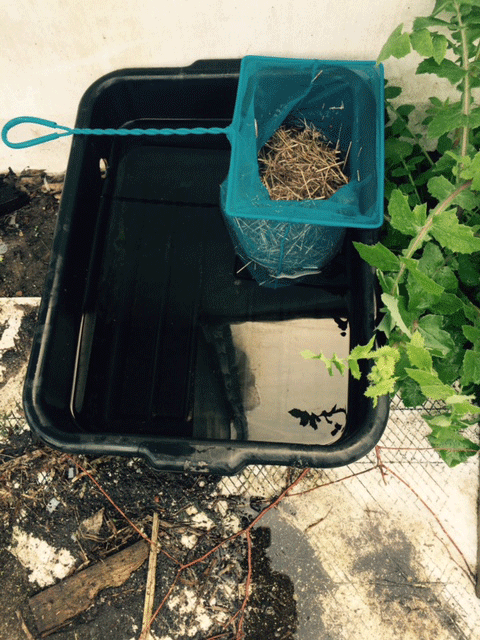Photo: A mosquito larvae culture system to raise live foods for fish.
I originally wrote this as an article in our monthly Newsletter (now dormant, but likely to be revived). I’ve made some edits, but it’s largely the same information. Also, it’s a timely blog since mosquito season will be starting in earnest this week here in south Texas.
In this blog I’m going to show you an easy way to raise a nutritious live-food for your fish, mosquito larvae. Before you say, “No way!” let me explain how you can do this without creating a nuisance for you and your neighbors. In fact, you’ll actually be helping to reduce the mosquito population in your area.
Start with any container that is relatively shallow. Styrofoam fish boxes are good. Even better, because they hold up longer, are plastic bus trays like those used in restaurants. You can find these at any restaurant supply company. I like the black ones made from recycled plastics; good for the environment.
To start, add about ten centimeters (about three inches) of water to your container; tap water (de-chlorinated) will work, but rainwater or RO water is better. Add a sprinkle of baker’s yeast. Okay, I usually add a level teaspoon of brewer’s yeast that I buy at our local agricultural feed store (I dislike English measurements, but everyone has a teaspoon). Then place some dead tree leaves or grass clippings into a netting bag. The foot of a pantyhose will work, or I just place the plant materials in 10” aquarium net (okay, I know English; but they’re sold in inches!) propped up in such a way the material remains in the net. Wet the leaves or grass clippings and place them in the net. If using a bag, make sure the netting bag sinks. The reason for the netting bag or the net is to make it easier to harvest the mosquito larvae later. Placing the leaves or clippings into a bag makes it easy to remove them. It’s not at all fun to separate the mosquito larvae from loose leaf litter.
Place the container outdoors in a shady location; under a shrub is good or anyplace you’ve noticed mosquitoes. Don’t place it where it is hit by direct sunlight. Within a couple of days you should see little brown rafts of eggs floating in the container. These will soon hatch out. The larvae will grow rapidly. How rapidly depends on the temperature. Here in south Texas we are able to raise mosquito larvae year-round, although they grow much faster during the summer than in the winter. In colder climes, you might not be able to raise them during the winter.
If you check out the photo at the top of this blog, you’ll see a 10” fish net laying across the top of a black bus tray. In the net is dried straw from a mowing I’d done about a week before. I like using dried leaves or straw, but fresh will work also. There is about three inches of water in the tray. The while area is a reflection off the white liner on one of our greenhouses. I placed the tray along the outside of the north wall where it is shaded by the greenhouse and a large hackberry tree to the west to provide adequate shade.
Now comes the important part: when to harvest before you have a crop of adult mosquitoes. As soon as you see the first pupae in the container. During the summer this will be after about two weeks from set up. Pupae are heavier and instead of being elongated are comma shaped. They swim distinctively differently from the larvae. If you aren’t certain, go online to find photos. It is important for your relations with neighbors and family members to harvest the container as soon as the first pupa is seen. Otherwise, you run the risk of producing adult mosquitoes. The easiest way to do this is to remove the stocking or net full of leaves or grass clippings and then pour the contents of the container through a fine meshed net. I like to use a 10” brine shrimp net. Rinse the larvae and pupae and feed to your fish. Watch carefully until you know how many your fish will eat so that you don’t stock your house with adult mosquitoes. If you have more than they can eat, the mosquitos can be frozen and used later when you can’t produce live larvae due to weather or schedule or mishap (like your dog “harvesting” your containers by turning them over; this has happened to me).
I like to set up a new container each day so that I have fresh mosquitoes to feed daily.
Good fishkeeping!


AD says
Good read. Thank you. I don’t have a tray like that, but I think a coffee can will do. I put some dried plant matter, I think they were sunflowers from last year, into a media bag, put it in the coffee can with some yeast and it is now sitting in a shady area in my back yard. It’s starting to hit 50 degrees out, so fingers crossed. I’ve been dying to feed my betta some fresh larvae. We get a lot of mosquitoes here, so even if they don’t grow in the can, I’m sure I’ll find some somewhere.
–AD
Charles Clapsaddle says
AD,
Your can should work. A pinch of yeast seems to attract females to lay eggs. The trays we use are bussing trays. Any restaurant supply house will have them.
Charles